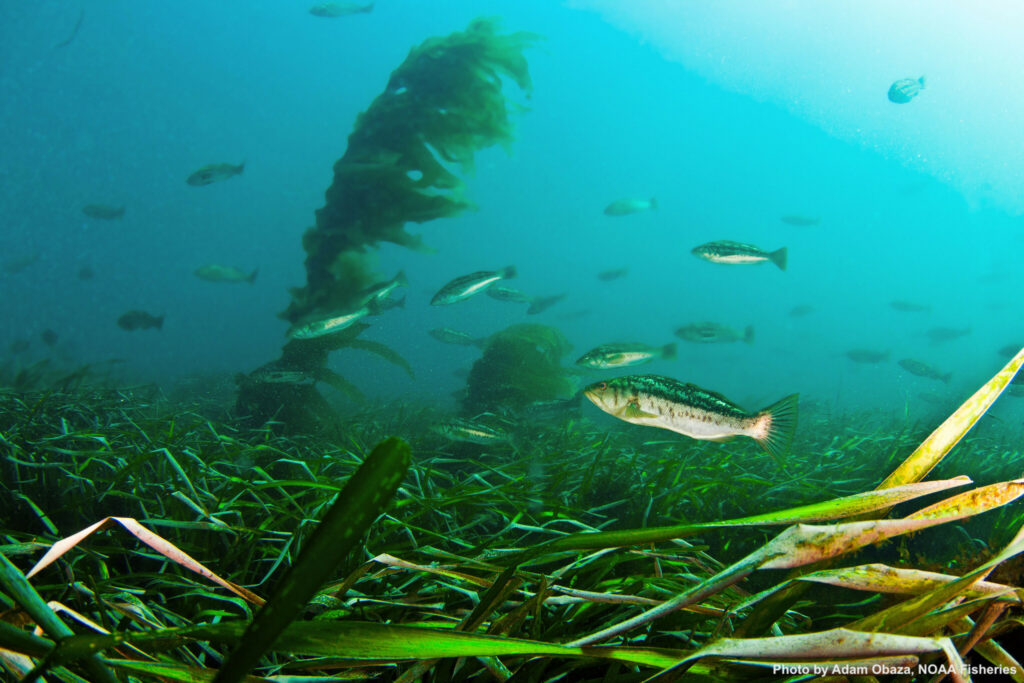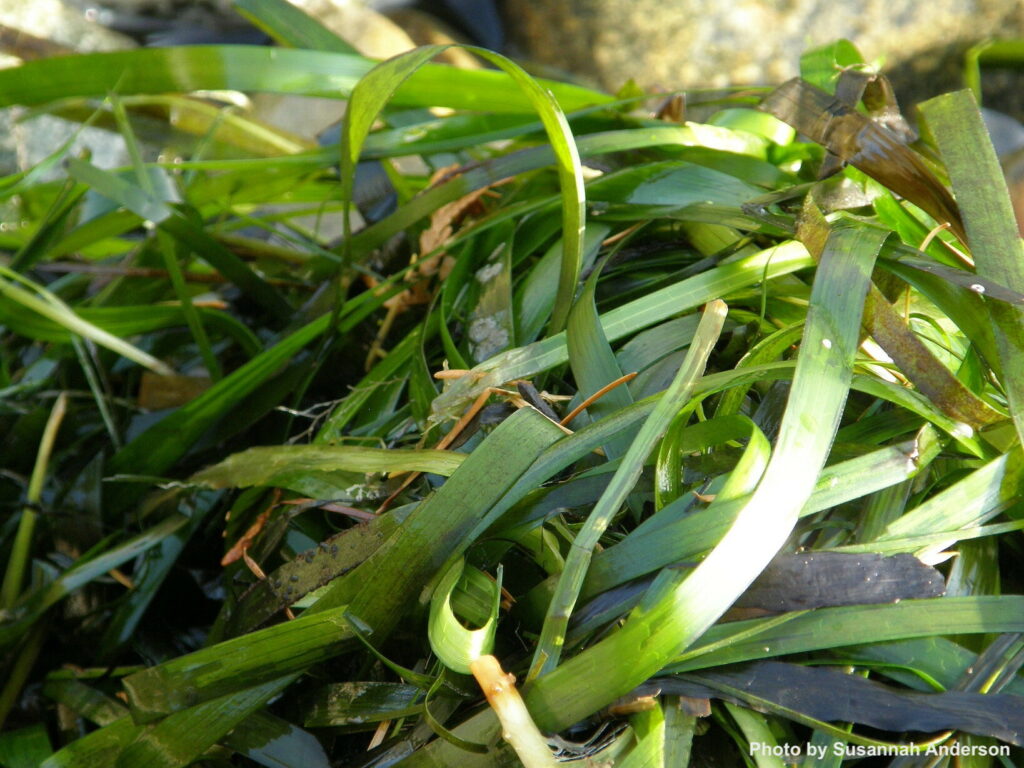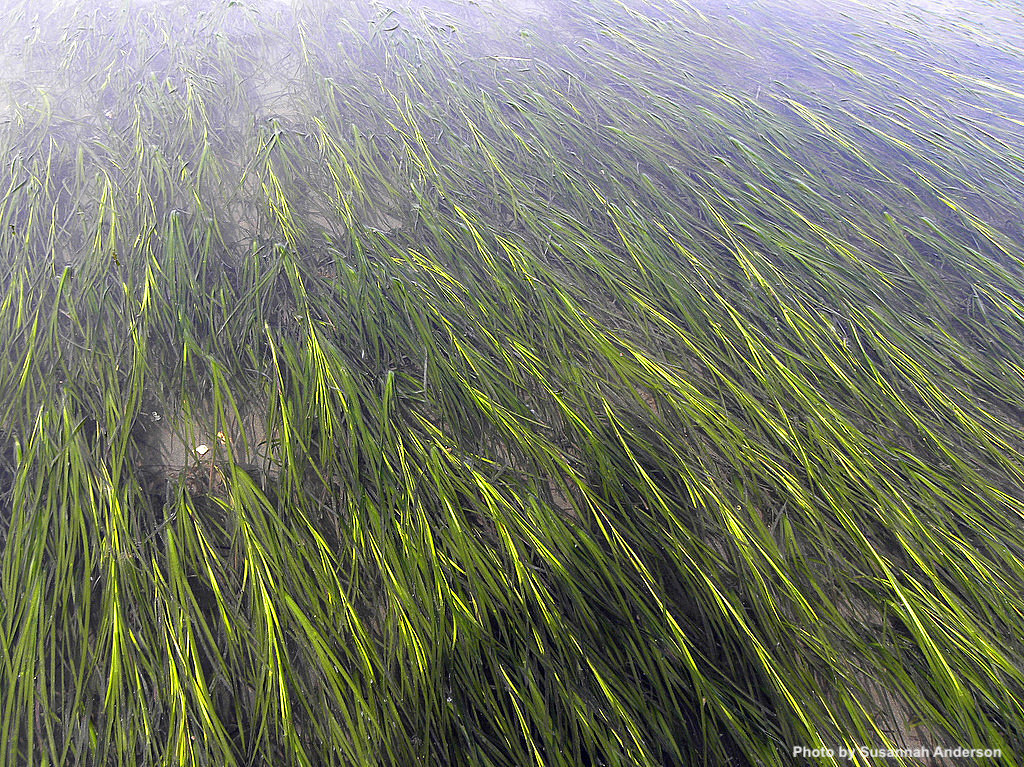Monday April 18, 2022

Eelgrass beds are one of the most fundamental but overlooked components of a thriving estuary ecosystem. Eelgrass (Zostera marina) is a seagrass, a group of saltwater-tolerant flowering plants that originated from marine algae. The unique evolutionary history of the roughly 70 species of seagrasses traces back to a subset of algae that adapted to live on land millions of years ago and acquired the capabilities of land plants during its stay, but then eventually returned to the sea where it lives today. Although seagrasses have a fascinating history, for generations they only caught the attention of plant enthusiasts. However, in the last decade, researchers have discovered that seagrasses have a remarkable capability to store “blue carbon,” or carbon that is sequestered in marine systems. Despite the important services it provides, eelgrass is threatened by industrial development, climate change, and human activities, which have severely degraded once-thriving meadows across the globe. Such losses have prompted a push to restore and protect this often underrated but highly valuable grassy habitat.
Found in coastal brackish and salty waters around the world, eelgrass beds are home to many invertebrates, fish, birds, and mammals. Their long, green, strap-like shoots anchored into the mud or sand form vast meadows that can, in some cases, be seen from space. Like land plants, eelgrass has branching elongated roots that creep below the muddy surface and gather nutrients while anchoring their delicate structures to the bottom, which keeps the eelgrass steadfast even when the tide shifts and the water rushes past its shoots. Among the many benefits they provide, eelgrass beds function as a filtration system and physically alter their surrounding environment by slowing down the speed of water during changing tides, which forces suspended sand and mud particles to fall to the benthos. Eelgrass is also an important ally for addressing climate change: along with other seagrasses, eelgrass beds on average capture and contain up to 35% more carbon from the atmosphere than some of the most productive rainforests in the world. Astonishingly, seagrasses only make up about 0.2% of the total seafloor but account for almost 10% of the global ocean carbon storage.

Eelgrass also creates three-dimensional habitat in otherwise open water, serving as a nursery, seasonal refuge, or permanent habitat for marine, freshwater, and anadromous fish. On the Pacific coast of the United States, commercially valuable fish like salmon use eelgrass beds as a seasonal refuge during their migration to the open ocean. In 1996, the United States government designated eelgrass beds as Essential Fish Habitat (EFH), which requires all federal entities to consult with NOAA fisheries scientists to reduce their impacts on eelgrass habitats. Furthermore, eelgrass beds are also considered a salmon Habitat Area of Particular Concern (HAPC), a subset under EFH that requires additional protections under the Magnuson-Stevens Act. Within California, a recent set of guidelines requires proof of zero net loss of eelgrass habitat as a result of all federal or state actions.
Besides sequestering carbon and forming physical habitat, eelgrass beds also absorb harmful nutrients introduced to the environment. Runoff, or pollution from coastal or inland-based industries, is high in nitrogen and phosphorous content and can easily make its way into estuaries via freshwater sources. Fortunately, eelgrass, like their plant cousins on land, thrive on nutrient-rich inputs that can act like a dose of fertilizer. However, a delicate balance must be maintained in any estuary. If nutrients exceed a specific threshold, algal blooms emerge on the water’s surface, blocking sunlight and choking out the eelgrass below. A stark example of this environmental shift has been recently demonstrated in Florida, where manatees are starving due to a severe die-off of seagrasses. The cumulative threats of human alterations and a changing planet have taken their toll on seagrasses worldwide: since 1879, when seagrass meadows were first described, over 29% of the total known meadow extent has disappeared, and their decline continues at a 1.5% net loss per year around the world. However, hundreds of restoration efforts are underway throughout the country, with more than a handful yielding local successes.

Eelgrass is unmatched in its ability to benefit species in marine, freshwater, and brackish environments by providing essential habitat and food for aquatic and terrestrial species alike. The urgent need to sequester excess atmospheric carbon and to maintain viable habitats for economically valuable species continues to motivate seagrass restoration efforts around the world. Despite the fact that historic data pre-dating worldwide eelgrass decline is non-existent, restoration efforts are striving to at least restore eelgrass beds to the sizes of meadows mapped in the early 1900s. Current restoration techniques consist of transplanting healthy individuals from neighboring eelgrass meadows or growing seedlings in a lab and transplanting them once they have reached a suitable size. While these restoration efforts have proven to be successful on local scales, they are costly and time-consuming, and continue to be affected by ongoing climate change and human impacts. However, increased recognition and appreciation for these humble grasses has placed eelgrass alongside mangroves and rainforests in the eyes of the conservation community as habitats that are worth the effort to preserve and restore.
This post was featured in our weekly e-newsletter, the Fish Report. You can subscribe to the Fish Report here.
